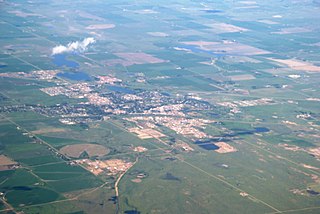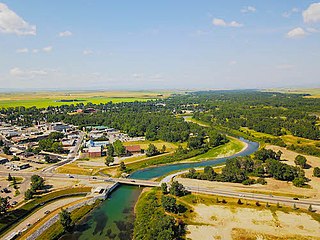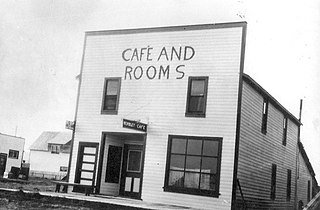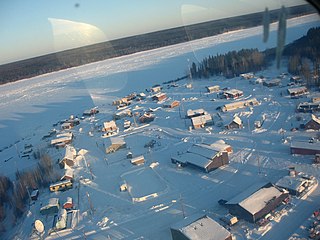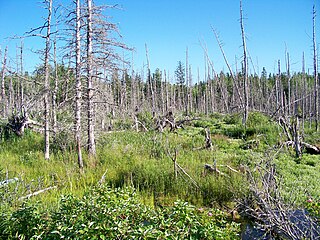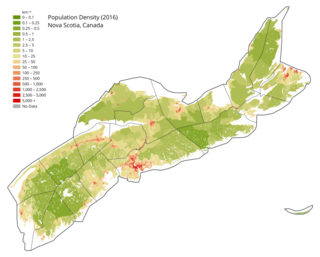The following table is a list of Canadian municipalities with a peak population of 5,000 or more which have experienced a population decline of 5% or more. [1] [2] [3] [4] [5] [6] [7] [8] [9] The three columns to the left of "Notes" will only be filled in if the 2011 population is not the lowest since the peak population.
| Municipality | Province/territory | Peak population (year) | 2011 population | Decline from peak | Percent decline from peak | Lowest population after peak (year) | Decline from peak | Percent decline from peak | Notes |
|---|---|---|---|---|---|---|---|---|---|
| Amherst [4] [10] [11] [12] [13] [14] | Nova Scotia | 10,788 (1961) | 9,717 | 1,071 | 9.9% | 9,470 (2001) | 1,318 | 12.2% | 2.2% increase from 2006. |
| Baie-Comeau [15] [16] [17] [18] | Québec | 26,861 (1981) | 22,113 | 4,748 | 17.7% | The 1981 population figure has been adjusted to reflect current municipal boundaries. | |||
| Cape Breton | Nova Scotia | 131,507 (1961) | 97,398 | 34,109 | 25.9% | Prior to August 1, 1995, the municipality was called Cape Breton County and was divided into several smaller municipalities. | |||
| Channel-Port aux Basques [4] [19] [20] [21] [22] | Newfoundland and Labrador | 6,105 (1981) | 4,170 | 1,935 | 31.7% | ||||
| Corner Brook | Newfoundland and Labrador | 26,309 (1971) | 19,886 | 6,423 | 24.4% | ||||
| Crowsnest Pass | Alberta | 7,306 (1981) [23] | 5,565 [24] | 1,741 | 23.8% | ||||
| Dawson City | Yukon | 9,142 (1901) [25] | 1,319 | 7,823 | 85.6% | 615 (1911) | 8,527 | 93.3% | |
| Elliot Lake | Ontario | 16,723 (1981) | 11,348 | 5,375 | 32.1% | ||||
| Flin Flon | Manitoba/Saskatchewan | 11,104 (1961) | 5,592 | 5,512 | 49.6% | Population figures are the totals of the Manitoba and Saskatchewan portions of the city. | |||
| Happy Valley-Goose Bay | Newfoundland and Labrador | 8,655 (1996) | 7,552 | 1,103 | 12.7% | ||||
| Hearst [26] [27] | Ontario | 6,079 (1991) | 5,090 | 989 | 16.3% | ||||
| Iroquois Falls | Ontario | 5,999 (1991) | 4,595 | 1,404 | 23.4% | ||||
| Kapuskasing | Ontario | 12,834 (1971) | 8,196 | 4,638 | 36.1% | ||||
| Kirkland Lake | Ontario | 13,599 (1971) | 8,493 [28] | 5,106 | 37.5% | 8,248 (2006) | 5,351 | 39.3% | 3.0% increase from 2006. |
| Kitimat [29] [30] [31] | British Columbia | 11,305 (1991) | 8,335 | 2,970 | 26.3% | ||||
| Labrador City | Newfoundland and Labrador | 11,538 (1981) | 7,367 | 4,171 | 36.2% | 7,240 (2006) | 4,298 | 37.3% | 1.8% increase from 2006. |
| Marystown [4] [32] [33] [34] | Newfoundland and Labrador | 6,742 (1996) | 5,506 | 1,236 | 18.3% | 5,436 (2006) | 1,306 | 19.4% | 1.3% increase from 2006. |
| Melville | Saskatchewan | 5,123 (1986) [35] | 4,517 [36] | 606 | 11.8% | 4,149 (2006) [36] | 974 | 23.5% | 8.9% increase from 2006. |
| Placentia [12] [37] [38] [39] | Newfoundland and Labrador | 5,515 (1991) | 3,643 | 1,872 | 33.9% | ||||
| Prince Rupert [40] | British Columbia | 16,714 (1996) | 12,508 | 4,206 | 25.2% | ||||
| Saint John | New Brunswick | 89,039 (1971) | 70,063 | 18,976 | 21.3% | 68,043 (2006) | 20,996 | 23.6% | 3% increase from 2006. |
| Springhill [41] [42] [43] [44] [45] | Nova Scotia | 7,170 (1941) | 3,868 | 3,302 | 46.1% | ||||
| Stephenville [32] [46] [47] | Newfoundland and Labrador | 7,764 (1996) | 6,719 | 1,045 | 13.5% | 6,588 (2006) | 1,176 | 15.1% | 2% increase from 2006. |
| The Pas [48] [49] [50] | Manitoba | 6,166 (1991) | 5,513 | 653 | 10.6% | ||||
| Thompson | Manitoba | 19,001 (1971) | 12,829 | 6,172 | 32.5% | ||||
| Wabana [4] [11] [32] [51] [52] | Newfoundland and Labrador | 8,026 (1961) | 2,346 | 5,680 | 70.8% | ||||
| Yarmouth [41] [42] [43] [44] [45] | Nova Scotia | 8,636 (1961) | 6,761 | 1,875 | 21.7% |
